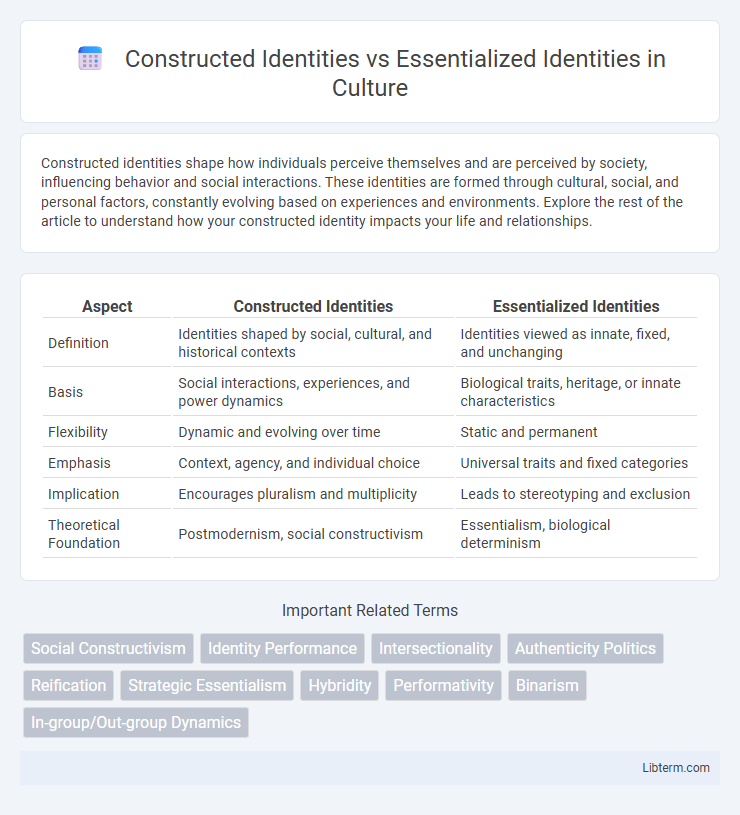Constructed identities shape how individuals perceive themselves and are perceived by society, influencing behavior and social interactions. These identities are formed through cultural, social, and personal factors, constantly evolving based on experiences and environments. Explore the rest of the article to understand how your constructed identity impacts your life and relationships.
Table of Comparison
| Aspect | Constructed Identities | Essentialized Identities |
|---|---|---|
| Definition | Identities shaped by social, cultural, and historical contexts | Identities viewed as innate, fixed, and unchanging |
| Basis | Social interactions, experiences, and power dynamics | Biological traits, heritage, or innate characteristics |
| Flexibility | Dynamic and evolving over time | Static and permanent |
| Emphasis | Context, agency, and individual choice | Universal traits and fixed categories |
| Implication | Encourages pluralism and multiplicity | Leads to stereotyping and exclusion |
| Theoretical Foundation | Postmodernism, social constructivism | Essentialism, biological determinism |
Understanding Constructed Identities: Definitions and Origins
Constructed identities emerge from social, cultural, and historical contexts, shaped by collective experiences and individual interactions rather than inherent traits. These identities are fluid and transformative, reflecting power dynamics, social norms, and personal narratives. Understanding constructed identities involves analyzing how language, media, and institutions contribute to the ongoing formation and negotiation of self and group identities.
What Are Essentialized Identities? Core Concepts Explained
Essentialized identities are fixed, often simplified categories that assume inherent, unchanging traits based on race, gender, ethnicity, or culture, ignoring individual differences and social contexts. Core concepts emphasize that these identities reduce complex human experiences to static labels, reinforcing stereotypes and limiting personal and social understanding. This contrasts with constructed identities, which view identity as fluid, shaped by social interactions, power dynamics, and historical change.
Historical Evolution of Identity Theory
Historical evolution of identity theory reveals a shift from essentialized identities, which view identity as fixed and innate, to constructed identities emphasizing social, cultural, and political influences shaping self-perception. Early identity theories rooted in biological determinism and stable categories gave way to postmodern perspectives recognizing identity as fluid, multiple, and context-dependent. Key thinkers like Stuart Hall and Michel Foucault highlighted power dynamics and discourse in the formation of identities, marking a paradigm shift in understanding identity as an ongoing process rather than static essence.
Key Differences: Constructed vs Essentialized Identities
Constructed identities are fluid and shaped by social, cultural, and historical contexts, emphasizing the evolving nature of self-perception and group belonging. Essentialized identities, by contrast, view identity as fixed, innate, and based on inherent traits such as race, ethnicity, or gender, often ignoring individual experiences or social changes. The key difference lies in the flexibility of constructed identities versus the static, predetermined nature of essentialized identities.
Social and Cultural Factors Influencing Identity Formation
Social and cultural factors profoundly influence identity formation by shaping constructed identities, which evolve through language, interactions, and cultural narratives. Essentialized identities, often rooted in perceived inherent traits like ethnicity or gender, overlook the fluid and dynamic nature of social roles and cultural contexts. Understanding this distinction highlights how identity is not fixed but continually reshaped by societal norms, historical experiences, and cultural practices.
The Role of Language in Shaping Identity
Language functions as a dynamic tool in constructing identities by enabling individuals to negotiate, express, and reshape their social selves in varying contexts. Unlike essentialized identities, which assume fixed, innate traits, constructed identities highlight linguistic practices as central to the fluid, performative nature of selfhood. Through discourse, narrative, and interaction, language shapes the continuous process of identity formation, reflecting power relations and cultural meanings embedded within social structures.
Media Representation and Identity Construction
Media representation plays a crucial role in shaping constructed identities, framing individuals and groups through narratives that reflect social, cultural, and political contexts rather than fixed traits. Constructed identities emphasize fluidity and multiplicity, challenging essentialized identities that portray identity as innate, static, and unchanging based on race, gender, or ethnicity. This shift in media representation allows for a more inclusive understanding of identity, highlighting the dynamic processes of self-definition and social categorization.
Impacts of Essentialism on Minority Groups
Essentialized identities simplify complex individual experiences into fixed, homogeneous traits, often marginalizing minority groups by reinforcing stereotypes and limiting social mobility. This reductionist approach can perpetuate discrimination in education, employment, and policymaking, resulting in systemic inequities and social exclusion. Challenging essentialism through recognizing constructed identities promotes inclusivity and reflects the dynamic, multifaceted nature of identity within diverse communities.
Constructed Identities in a Globalized World
Constructed identities in a globalized world emerge through dynamic interactions influenced by migration, cultural exchange, and digital connectivity, allowing individuals to negotiate and redefine their sense of self beyond fixed categories. These identities are fluid, shaped by social, political, and economic contexts, enabling adaptability and hybridization across diverse environments. The emphasis on constructed identities challenges essentialized notions by highlighting the multiplicity and situational nature of identity formation in an interconnected world.
Moving Forward: Embracing Fluid and Intersectional Identities
Moving forward with identity, embracing fluid and intersectional identities allows individuals to transcend rigid, essentialized definitions that limit self-expression. Constructed identities highlight the social and cultural processes shaping identity, promoting adaptability and inclusivity in diverse contexts. This approach fosters understanding across multiple identity facets, such as race, gender, and class, supporting personal growth and social cohesion.
Constructed Identities Infographic

 libterm.com
libterm.com